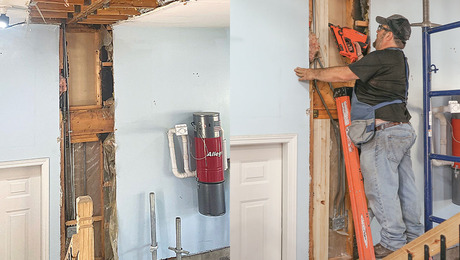*
We currently have a 7 year old Weil-McClain oil-fired furnace with a coil for hot water. It strikes me as inefficient to be firing up the furnace all summer long (in New England) to get hot water. How might I assess the payback of installing a hot water heater? My options are oil, electric or propane. If the coil is providing enough hot water, is there energy savings to be had by switching? THANKS.
Discussion Forum
Discussion Forum
Up Next
Video Shorts
Featured Story

Don't buy in to the TV show nightmares—when you uncover something unforeseen on a remodeling project, take these steps to keep the process moving and fix the issue.
Highlights
"I have learned so much thanks to the searchable articles on the FHB website. I can confidently say that I expect to be a life-long subscriber." - M.K.














Replies
*
Greg-
we went through this same mental exercise when our hot water coil needed to be replaced. We looked at three options: 1. replace the coil (least expensive), 2. get rid of the coil and add an external hot-water tank (40-gallon Amtrol), or 3. setup a hybrid system that used oil in the winter and electricity in the summer.
We chose to install the Amtrol tank -- for a variety of reasons. This is our second summer with the boiler on year 'round and we burn next to no oil, surprisingly (our boiler was tested at 82% efficiency). I'm sure someone can do the math and show you that my approach isn't the most efficient, but the combination of some efficiency, enormous hot water volume and ease of use to operate the system sold me.
We also have a generator setup to supply our boiler, circulators and water pump (among other things) with electricity during a power outage. It's nice to have hot water when the power is out for a couple of days without having to buy a 15,000 watt generator!
We're now looking into a fourth option, which is using solar panels to pre-heat our domestic hot water and water for the boiler. I doubt the economics are there to make the project worthwhile. In the meantime, I can't rave enough about the Amtrol tank.
s.
*Keep the coil, add a bronze circulator pump to the coil going into an inexpensive electric hot water heater with the heating elements disconnected. Use the water heater's thermostat to control the cirulator. Circulator takes heated water from the coil, sends it into one end of the water heater, out the other end of the water heater and back into the other end of the coil. Basically extends the capacity of the boilers coil.Boiler high temp can be set lower to a very efficient temp (140* to 160*) instead of the usual 180*-plus. Water heater thermostat set to 10 to 20 degrees below the boiler temp.Pump the hot water from the coil to the bottom of the (now) storage tank, with a tee fitting between the tanks drain valve and the tank. Take the water from the top of the tank COLD port (with dip tube cut short) and pipe to inlet of the boiler coil.Hot water to the faucets comes from tank's HOT port. "Feed" water now goes into the tank bottom with the drain and coil output (add another TEE) or feed it with a TEE to the boiler coil's inlet side as normal. JMHOPhil
*All good advice.Tankless coils are WAY inefficient. 35% for 2 occupants, up to 70% for 7 occupants. The fewer occupants, the less efficient they are due to cycling.The above methods effectively convert the unit to an indirect tank, this is agood thing. Good boiler run times.-Rob
*The circulator & electric-waterheater-as-storage-tank on the existing coil is considerably less expensive than an Amtrol "zone" indirect storage tank. JMHO, having an oil fired boiler run a bit for hot water during non-heating months is a good thing. Some oil burners don't fire up for that first October cold snap after being off for 6 months.Phil
*Thanks for the advice. Phil, when you say an "inexpensive electric water heater" what specifically are you suggesting in terms of capacity (gallons)??? Does it matter? THANKS.
*It really doesn't matter what size you use. But bigger is better in stand-by hot water capacity, although it does encourage very long hot showers! A fifty gallon size would do nicely. Add an insulation wrap to the tank and the pipings. If you wanted to get fancy, use a three way anti-scald/mixing valve on the HOT outlet from the tank. That can effectively expand your storage tank capacity. If the tank water temp is for example 130*, and the mixing valve blends in some cold water with the HOT outlet (that leads to faucets/shower) making the water at around 105*, you're not only protecting your family from scalds but making the hot water in the tank last much longer.HTH,Phil
*
We currently have a 7 year old Weil-McClain oil-fired furnace with a coil for hot water. It strikes me as inefficient to be firing up the furnace all summer long (in New England) to get hot water. How might I assess the payback of installing a hot water heater? My options are oil, electric or propane. If the coil is providing enough hot water, is there energy savings to be had by switching? THANKS.